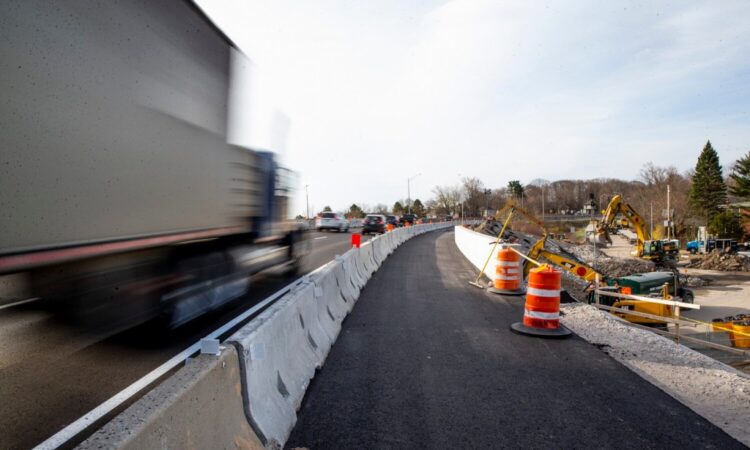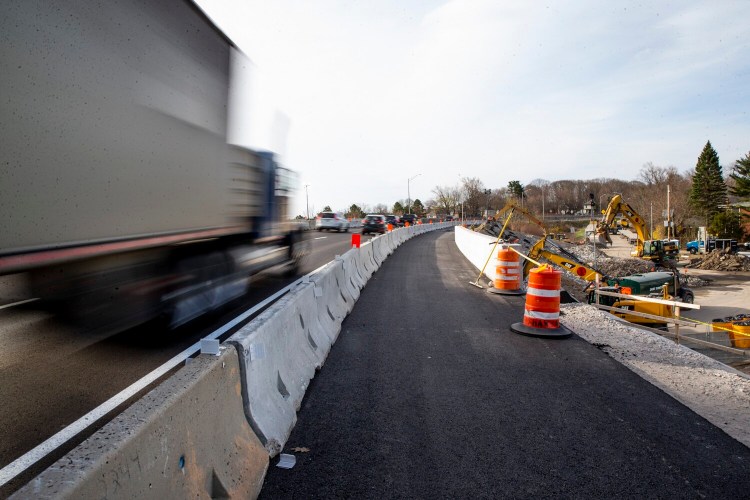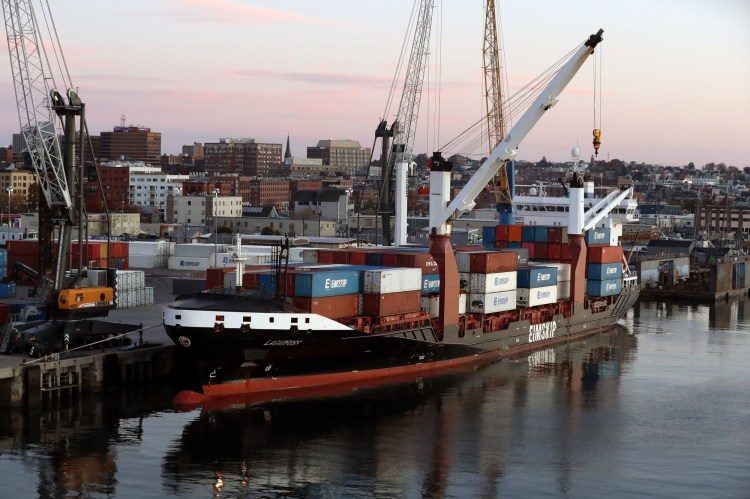New 3-year transportation plan includes $4.74 billion in projects and investments



Traffic travels southbound across the Veranda Street Bridge on I-295 in Portland in 2022. Derek Davis/Staff Photographer
The Maine Department of Transportation’s three-year work plan released Thursday calls for $4.74 billion in highway and bridge projects, port and rail improvements, and other investments in the state’s transportation systems.
The rolling plan, updated annually to address Maine’s most pressing and fundable transportation needs, lays the groundwork for record spending via state and federal programs through 2026, including more than $1 billion from the U.S. Department of Transportation.
Major projects include the reconstruction of Route 1 between Frenchville and Fort Kent ($27.7 million); safety and mobility improvements in North Windham ($31.2 million); and improvements to culverts and fish passages in Down East Maine, central Maine and the Sandy River Watershed ($27 million). A $28 million grant will be used to design and build a hybrid ferry to carry passengers and vehicles between Lincolnville and Islesboro.
At the federal level, the 2021 Bipartisan Infrastructure Law allowed the state to compete for special funding through discretionary grant programs and congressionally directed spending. That will nearly double the amount of federal funding Maine received before the law was passed.
At the state level, Gov. Janet Mills and legislators unanimously supported a new funding mechanism for the state highway fund last June that made it less reliant on fuel taxes and bonding. The bipartisan law taps 40% of auto sales taxes, generating more than $100 million annually for transportation projects.
“Now, we can make real transportation improvements for the people of Maine,” MDOT Commissioner Bruce Van Note said. “When you have reliable funding, you can make reliable plans. It helps us pivot from making do to making real progress.”
The plan contains 2,672 individual work items, including capital projects, maintenance, operations, planning and administration for 2024, 2025 and 2026. The plan doesn’t include the estimated $10 million cost of ongoing repairs following flood damage from the Dec. 18 storm, which is expected to be reimbursed by the federal government; or the cost of fixing state property damaged in last week’s storms, which has yet to be tallied and also may be reimbursed, he said.
More than $3 billion will be invested in roads and bridges, including $846.2 million for 267 bridge projects and $684 million for 285 miles of highway construction and repair. The plan also calls for $235.4 million in transit investments, $220 million for aviation, $259 million for freight projects and passenger rail operations, and $165.5 million to support the development of ports and marine infrastructure.
Transit investments include $95.5 million in capital projects and $139.9 million to support transit operations. Allocations include $4 million for a two-year pilot bus service between Portland and Lewiston to support workforce development; $9.8 million to upgrade Bangor’s Community Connector bus storage facility and accommodate future electric vehicle charging equipment; and $1.5 million to support the GO Maine ridesharing program, in partnership with the Maine Turnpike Authority.


The container ship Largarfoss from Eimskip, an Icelandic shipping company, is docked at the International Marine Terminal in Portland in 2022. Ben McCanna/Staff Photographer
“Not everyone owns a car and not everyone wants to,” Van Note said. “In places where there’s population density, increasing public transit is a priority.”
The work plan provides $53.1 million to support Amtrak Downeaster operations and $204.8 million for capital freight projects, including $76 million to improve the state rail network to support heavy rail cars and double-stack clearances; $35 million for improvements to the CSX line between Gray and Waterville; and $16 million to rehab 13 bridges – 12 on the Northern Maine Rail Network and one over the New Meadows River in West Bath.
“Every year, more than 1 million tons of freight move over state-owned rail lines,” the plan states. “That’s the equivalent of 63,000 trucks. The freight rail network provides critical infrastructure that supports the movement of goods and materials, and this helps strengthen our state’s economy.”
Port and marine capital projects in the plan include the installation of a refrigeration rack at the new cold storage facility at the International Marine Terminal in Portland ($17.8 million); continued development of Maine’s offshore wind industry ($10 million); and doubling the annual funding for the Small Harbor Improvement Plan program ($9.4 million).
Planned investments in Maine’s six commercial airports and 29 general aviation airports include $49.1 million to rebuild and maintain runways, aprons and taxiways; $29.3 million for runway reconstruction at Bangor International Airport, in cooperation with the Maine Air National Guard and U.S. Department of Defense; $16.4 million for terminal projects at Bangor International and Dexter Regional airports; and $13.3 million for airfield lighting, snow-removal equipment and other capital improvements.
The work plan also continues the state’s efforts to combat climate change by supporting data-driven and practical work to reduce emissions in the transportation sector and increase infrastructure resiliency.
“Recent storms in Maine and beyond have caused devastation in so many communities, a stark reminder of why we need to make transportation stronger and more resilient,” Maria Fuentes, executive director of the Maine Better Transportation Association, said in a statement.
“MBTA is hopeful that any increase in funding will translate into more investments for more durable infrastructure – more rebuilding and reconstruction of roads, bridges, tracks, culverts and other needs. No longer can we rely on ‘patch and pray;’ the state needs to make significant investments in our aging infrastructure to meet the needs of today and the future or risk the peril of falling too far behind.”
Kelly Flagg, executive director of Associated General Contractors of Maine, said the organization is preparing to meet the demand for increased production by expanding the Maine Construction Academy.
“This programming will include pre-apprenticeship, apprenticeship and incumbent workforce up-skilling, (and) will support growth of the construction and transportation workforce both now and into the future,” she said.
The full plan, which includes a breakdown of projects in specific communities, can be viewed at: maine.gov/mdot/.
Related Stories


Invalid username/password.
Please check your email to confirm and complete your registration.
Use the form below to reset your password. When you’ve submitted your account email, we will send an email with a reset code.